Jasper Lake Fanless Showdown: ECS LIVA Z3 and ZOTAC ZBOX CI331 nano UCFF PCs Review
by Ganesh T S on July 8, 2022 8:30 AM EST- Posted in
- Systems
- ZOTAC
- Fanless
- ECS
- Passive Cooling
- UCFF
- Mini-PC
- Jasper Lake
GPU Performance
In moving from Gemini Lake to Jasper Lake, the integrated GPU didn't get as much attention as the CPU did. While retaining the same microarchitecture, the shift to 10nm allowed for integrating more execution units and slight improvements in the maximum clocks. The systems we are looking at today come with different variants of the same GPU microarchitecture:
- Intel June Canyon and ECS LIVA Z2 (Gemini Lake): 18EU @ 750 MHz
- ECS LIVA Z3 / JSLM-MINI (Jasper Lake): 32EU @ 850 MHz
- ZOTAC ZBOX CI331 nano (Jasper Lake): 24EU @ 850 MHz
Based on these specifications alone, we expect the JSLM-MINI / LIVA Z3 to handily best the other systems in GPU performance. However, there are a few caveats to consider:
- Power budget / PL1 limit is higher for the ZBOX CI331 nano compared to the JSLM-MINI
- The June Canyon NUC is actively cooled and is not affected by thermal throttling
- The LIVA Z3 and JSLM-MINI operate with DDR4-2666 SODIMMs, while the ZBOX operates with DDR4-2933 SODIMMs
Keeping these aspects in mind, the GPU performance has to be evaluated in the context of each workload. We put the systems through some standard 3D workloads to get an idea of what they have to offer for GPU-intensive tasks.
GFXBench
The DirectX 12-based GFXBench tests from Kishonti are cross-platform, and available all the way down to smartphones. As such, they are not very taxing for discrete GPUs and modern integrated GPUs. We processed the offscreen versions of the 'Aztec Ruins' benchmark.
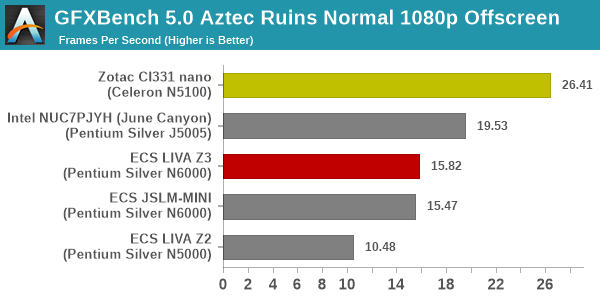
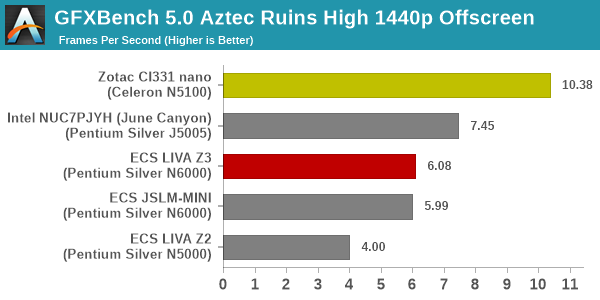
The ZBOX CI331 nano's iGPU has extra EUs compared to the June Canyon NUC. It also has faster RAM access. Though the number of EUs is lesser than the iGPU's in the LIVA Z3 / JSLM-MINI, the higher PL1 limit and faster RAM access help the ZBOX to emerge as the leader in both GFXBench workloads.
UL 3DMark
Four different workload sets were processed in 3DMark - Fire Strike, Time Spy, Night Raid, and Wild Life.
3DMark Fire Strike
The Fire Strike benchmark has three workloads. The base version is meant for high-performance gaming PCs. It uses DirectX 11 (feature level 11) to render frames at 1920 x 1080. The Extreme version targets 1440p gaming requirements, while the Ultra version targets 4K gaming system, and renders at 3840 x 2160. The graph below presents the overall score for the Fire Strike Extreme and Fire Strike Ultra benchmark across all the systems that are being compared.
| UL 3DMark - Fire Strike Workloads | |||
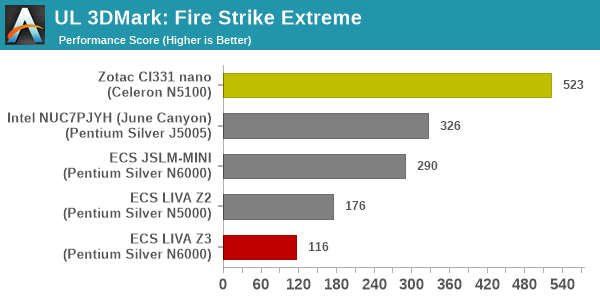
The Extreme workload sees the CI331 nano come out comfortably on top for the same reasons as the ones discussed in the GFXBench subsection - the higher PL1 limits, extra EUs compared to June Canyon, and faster DRAM. The Ultra workload (which doesn't make much sense for UCFF PCs based on low-power processors like Jasper Lake anyway) sees both the LIVA Z3 and the ZBOX CI331 nano get timed out - in all probability due to thermal throttling.
3DMark Time Spy
The Time Spy workload has two levels with different complexities. Both use DirectX 12 (feature level 11). However, the plain version targets high-performance gaming PCs with a 2560 x 1440 render resolution, while the Extreme version renders at 3840 x 2160 resolution. The graphs below present both numbers for all the systems that are being compared in this review.
| UL 3DMark - Time Spy Workloads | |||
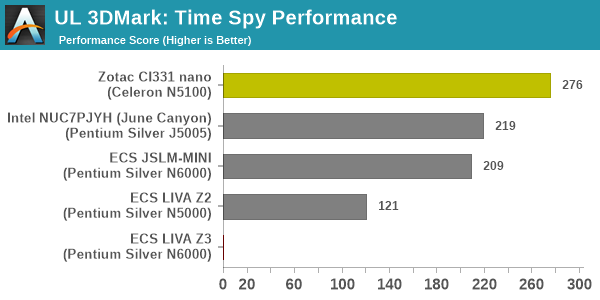
The LIVA Z3 is thermally limited to the extent that neither Time Spy workload completes. The extra EUs and faster RAM help the ZBOX in the normal Time Spy workload. However, at higher resolutions (Extreme), the ZBOX gets thermally limited and its lowered power budget is insufficient to see it get past the June Canyon and JSLM-MINI.
3DMark Wild Life
The Wild Life workload was initially introduced as a cross-platform GPU benchmark in 2020. It renders at a 2560 x 1440 resolution using Vulkan 1.1 APIs on Windows. It is a relatively short-running test, reflective of mobile GPU usage. In mid-2021, UL released the Wild Life Extreme workload that was a more demanding version that renders at 3840 x 2160 and runs for a much longer duration reflective of typical desktop gaming usage.
| UL 3DMark - Wild Life Workloads | |||
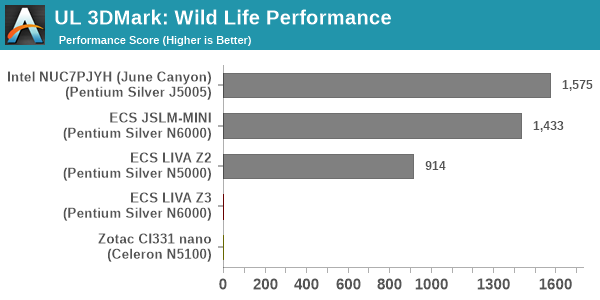
The Wild Life workload was again a mixed bag for the ZBOX, with thermal behavior causing timeouts. The LIVA Z3 failed in both components. Active cooling and a consistent power budget actually see the Gemini Lake-based June Canyon NUC on the leaderboard this time.
3DMark Night Raid
The Night Raid workload is a DirectX 12 benchmark test. It is less demanding than Time Spy, and is optimized for integrated graphics. The graph below presents the overall score in this workload for different system configurations.
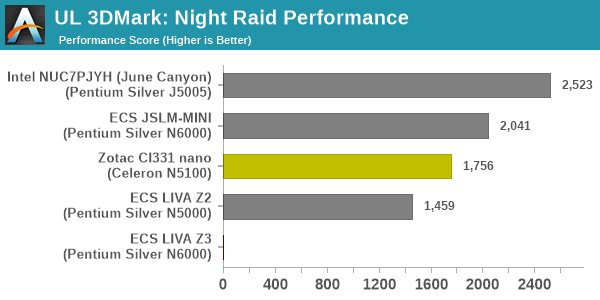
Power budget seems to be the primary factor for the Night Raid workload. The June Canyon NUC is at the top despite its limited EUs and slower RAM. The JSLM-MINI is able to sustain a 6W PL1 for extended durations, and coupled with the extra EUs over the CI331 nano, it handily bests the ZBOX in this workload.










52 Comments
View All Comments
Oxford Guy - Monday, July 18, 2022 - link
‘No, you're flat-out wrong’That’s nice.
imofullform - Thursday, July 21, 2022 - link
Nice Post